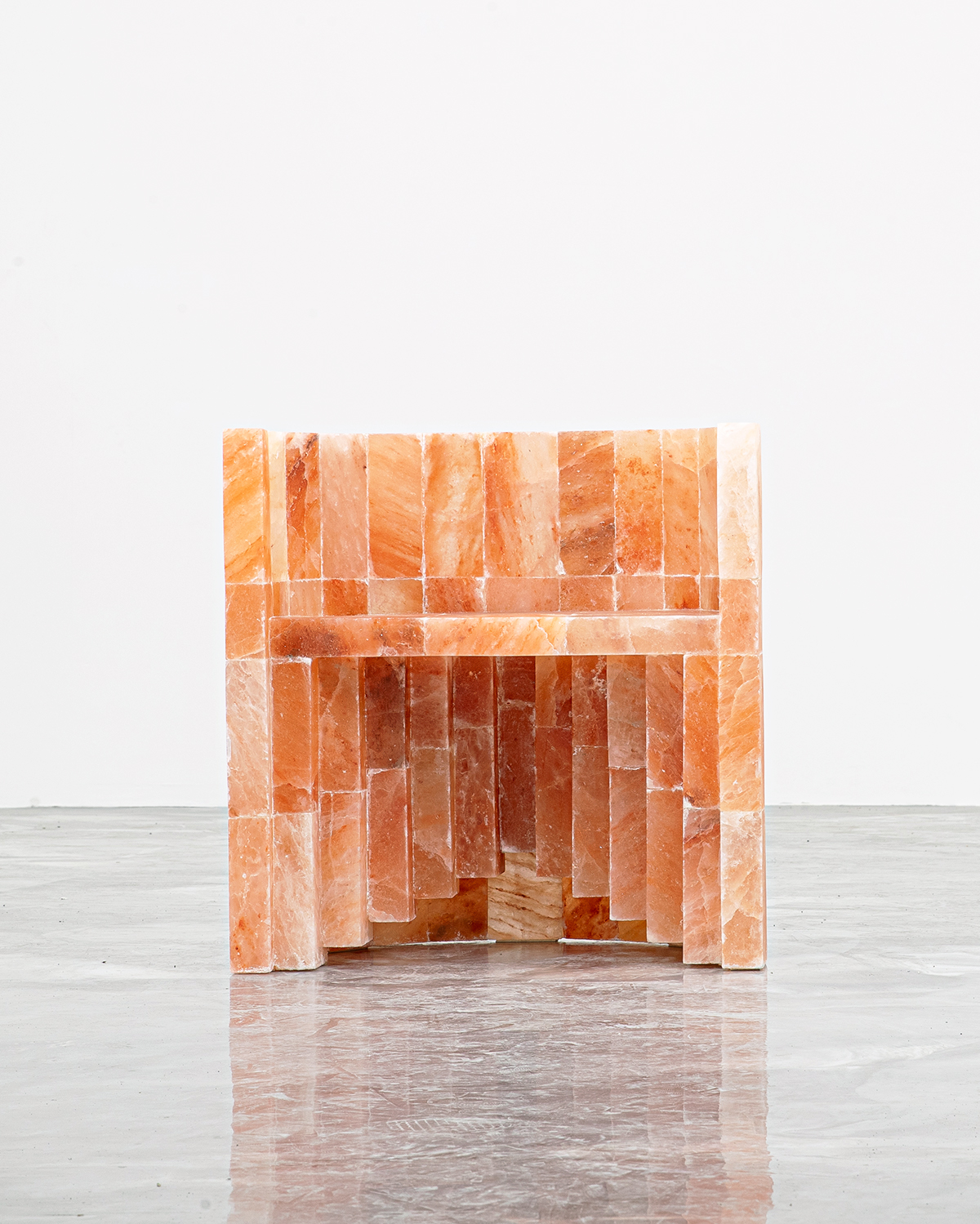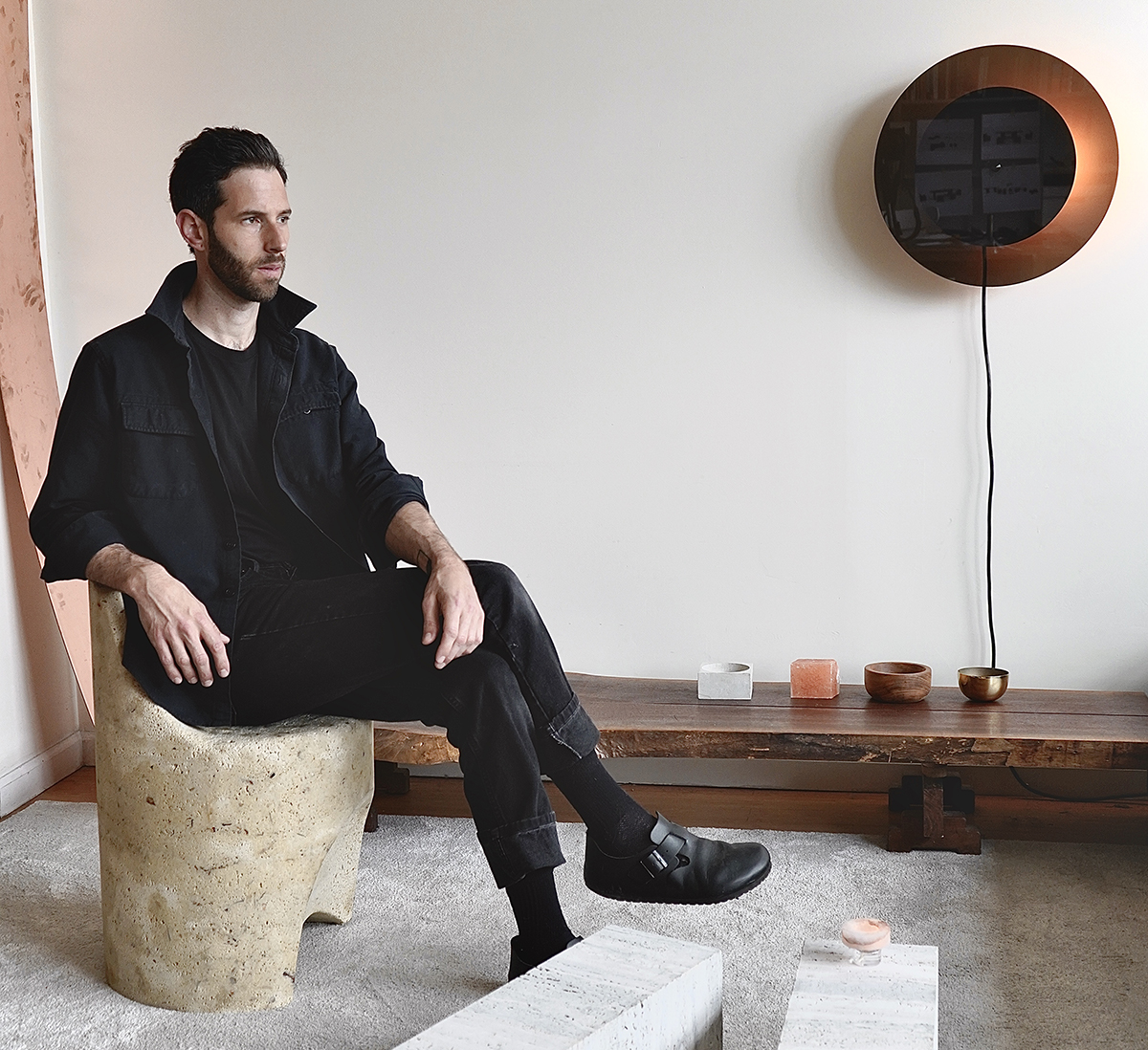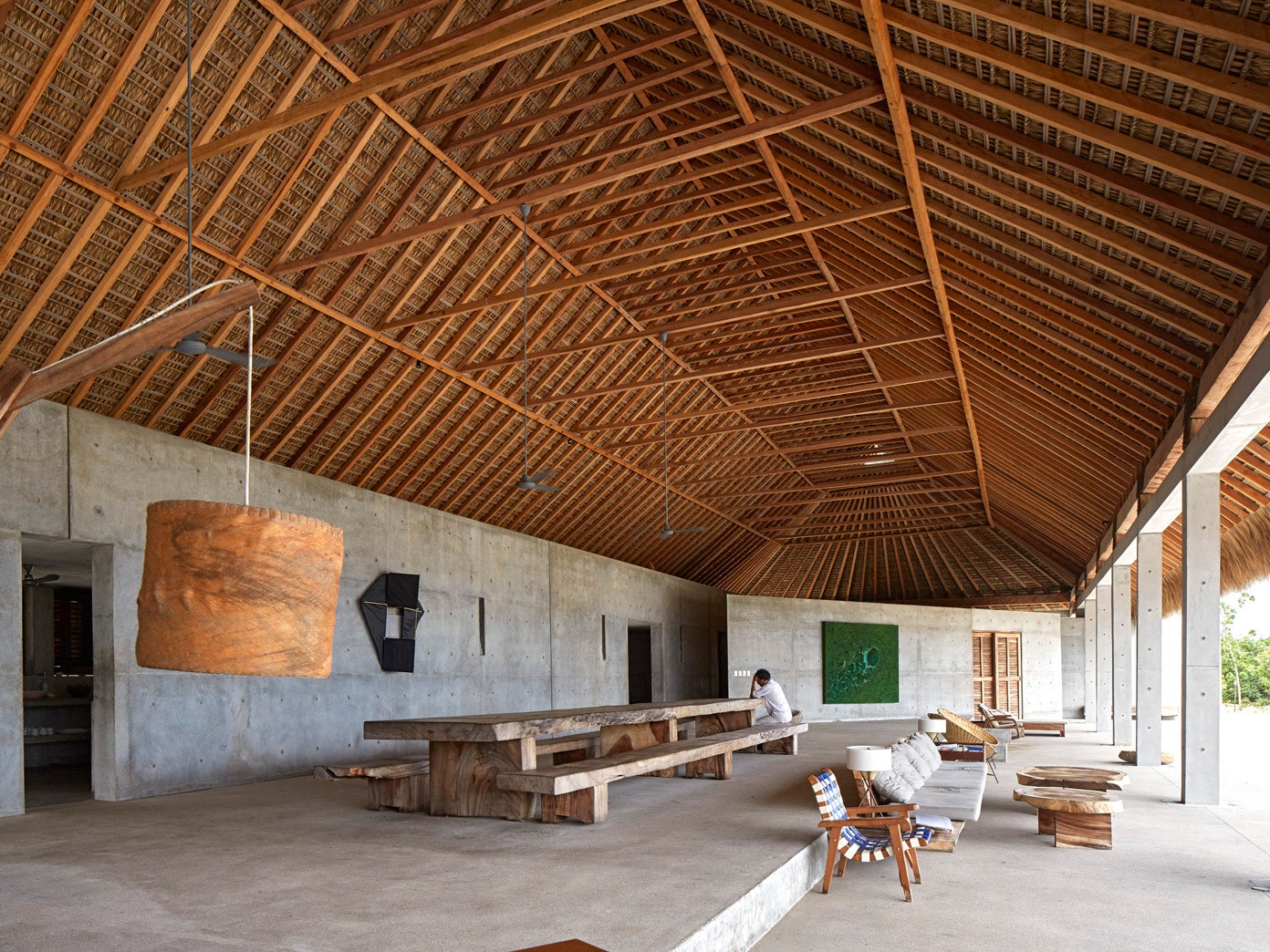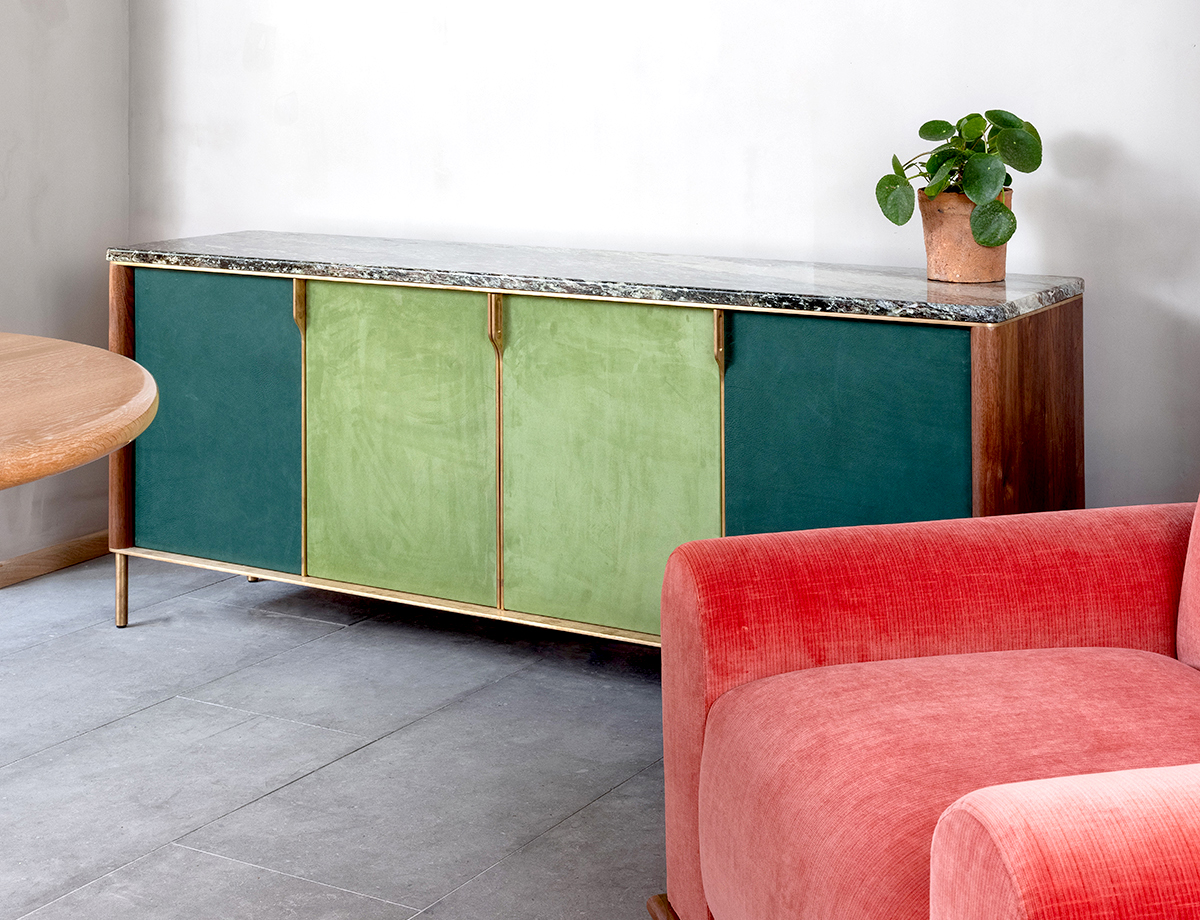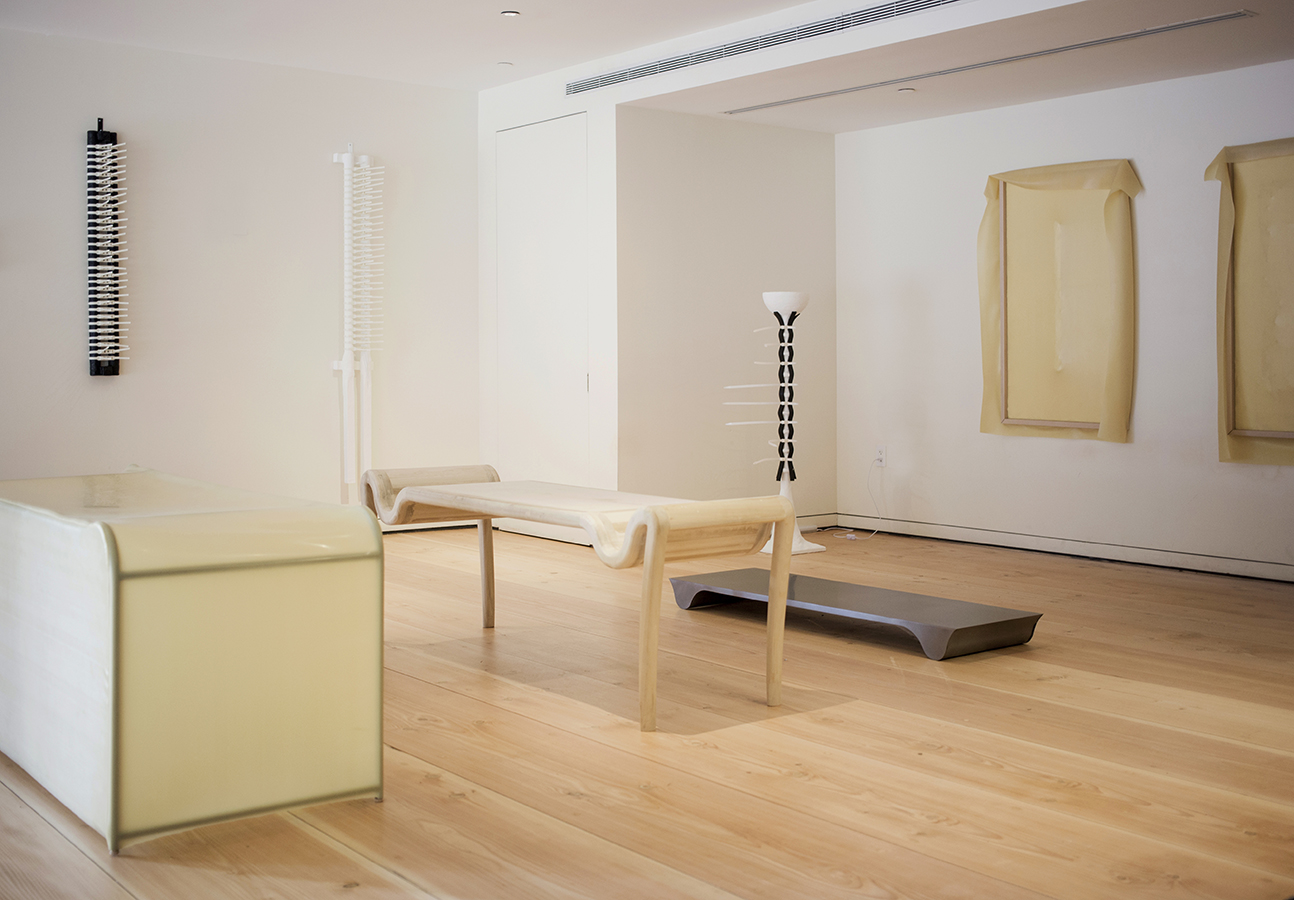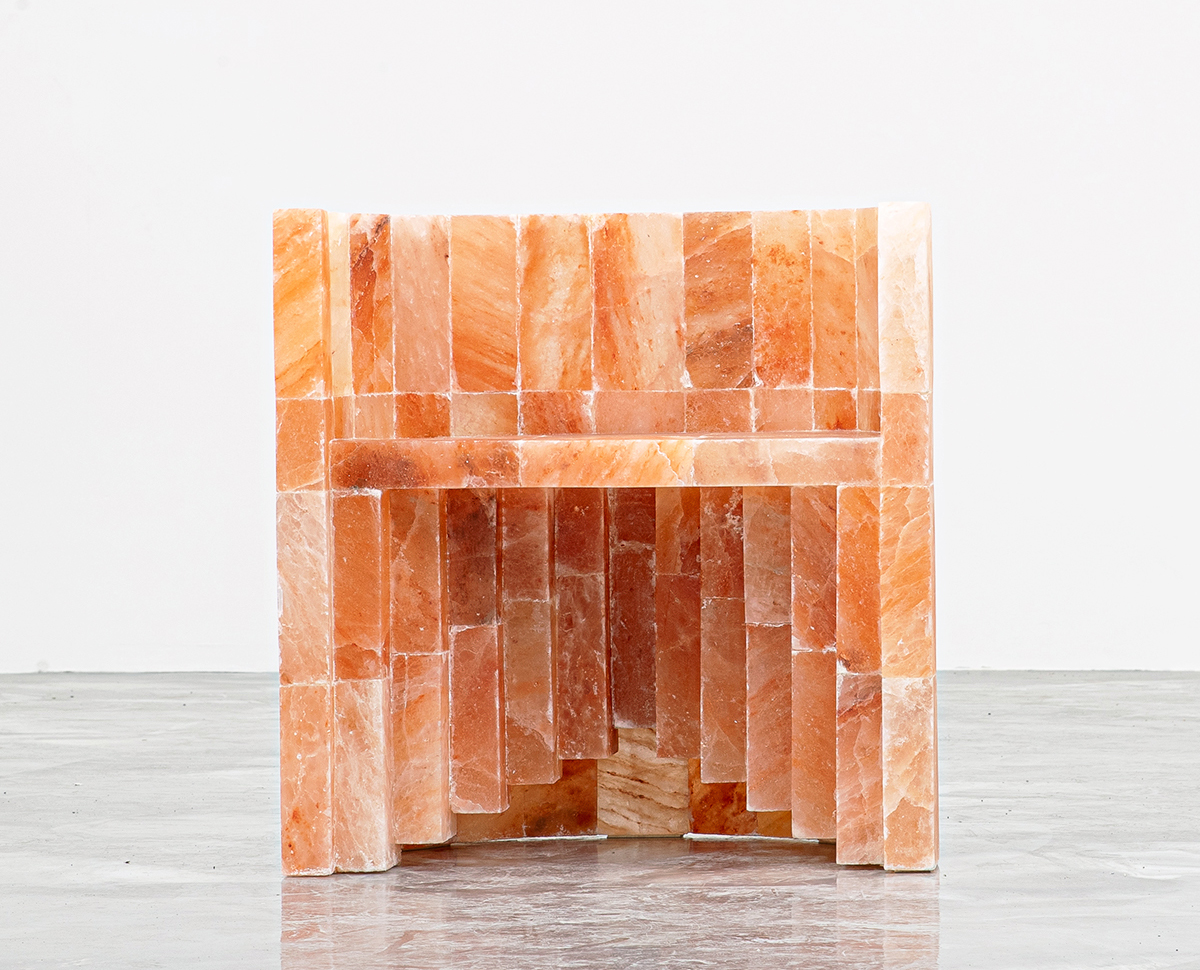
02.24.21
Up and Coming
Travertine, Salt, and Wood: Gregory Beson and the Beauty of Tangible Materials
There’s something refreshingly thoughtful about the way New York–based furniture designer and Parsons professor Gregory Beson talks about his practice. He may be represented by Love House in New York and Rossana Orlandi in Milan (where you can see his chair built with bricks of pink Himalayan salt, which stole the show at Fernando Mastrangelo’s In Good Company exhibition in 2019), but when discussing his recent collection, Home Group One, it’s not some white-gloved gallery where he pictures it. “I see the pieces as plinths for living,” says the Massachusetts-born designer, describing the series of tables, chairs, and shelving formed of interlocking planes of solid walnut. “None of them should be bare in space. A table should have a beautiful textile covering it with a candle and a table setting. The side tables should hold your favorite book or maybe stones you found on the beach or dried flowers.” It’s all part of an approach he considers holistic design: a process that takes into account not only the design and build of each piece — from form to material choice — but rather, the entire community of people who in some way touch the process. “My emphasis is on a practice and way of living which is inherently inquisitive and focused on challenging my own assumptions,” he says.
In conversation, he’s prone to zig-zagging between long, introspective tangents. Toggling from the investigations central to his own work — the potential of materials, the concept of home, his own writing — and the larger trends he sees happening community around him (hint: he’s really not into render-only projects). We spoke with him over the phone to discuss the new collection, his background as a musician, and how it takes a village to make a chair.
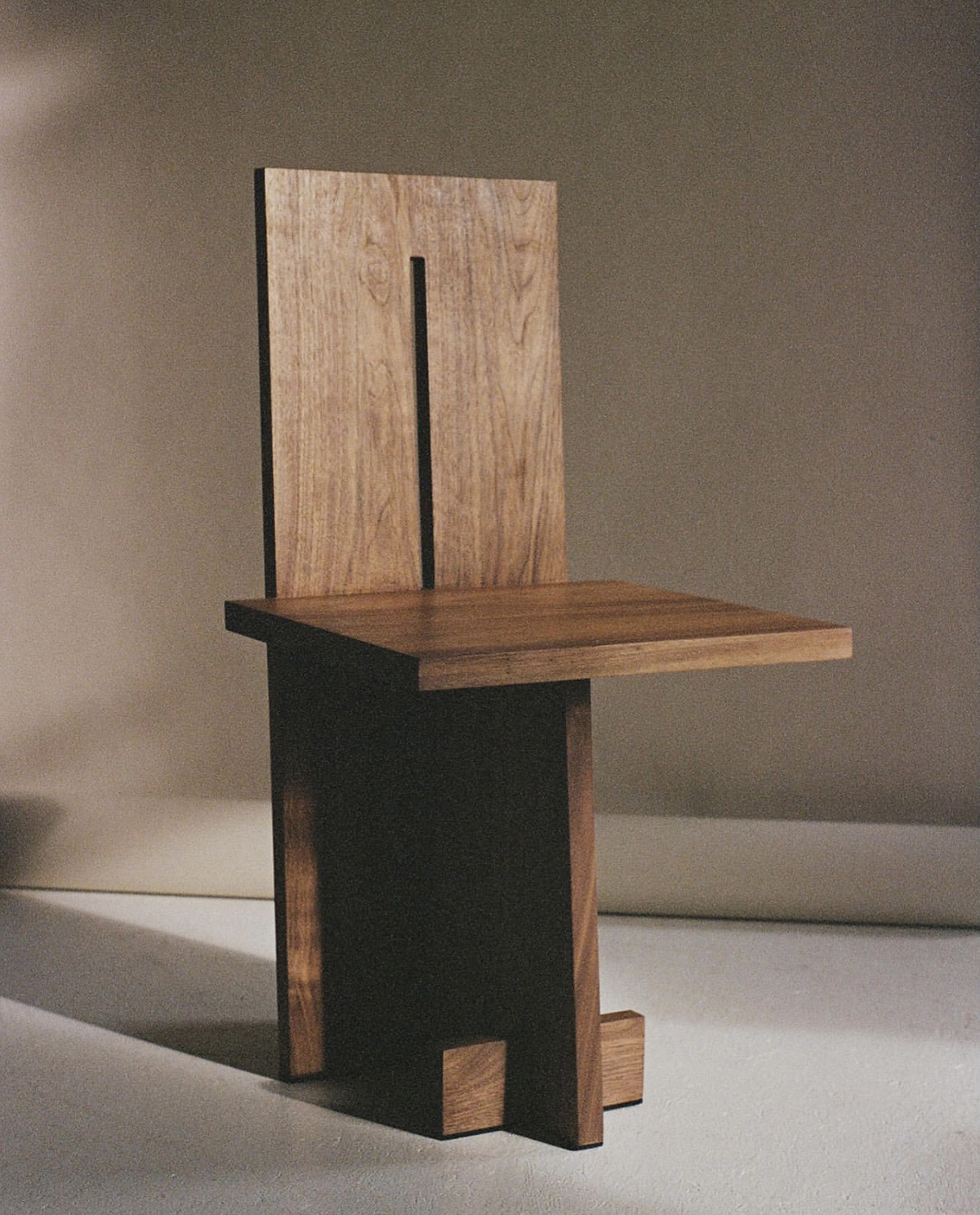
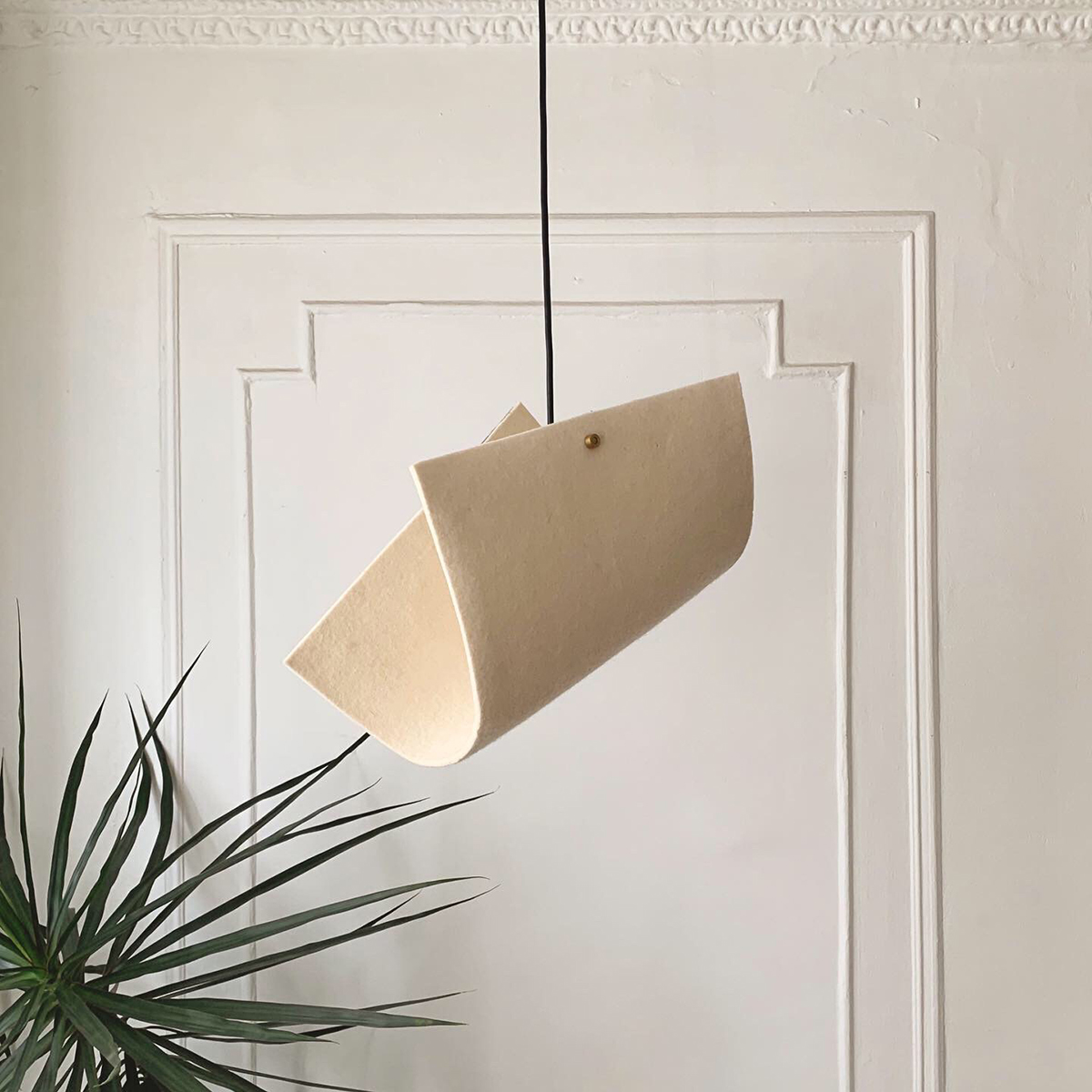
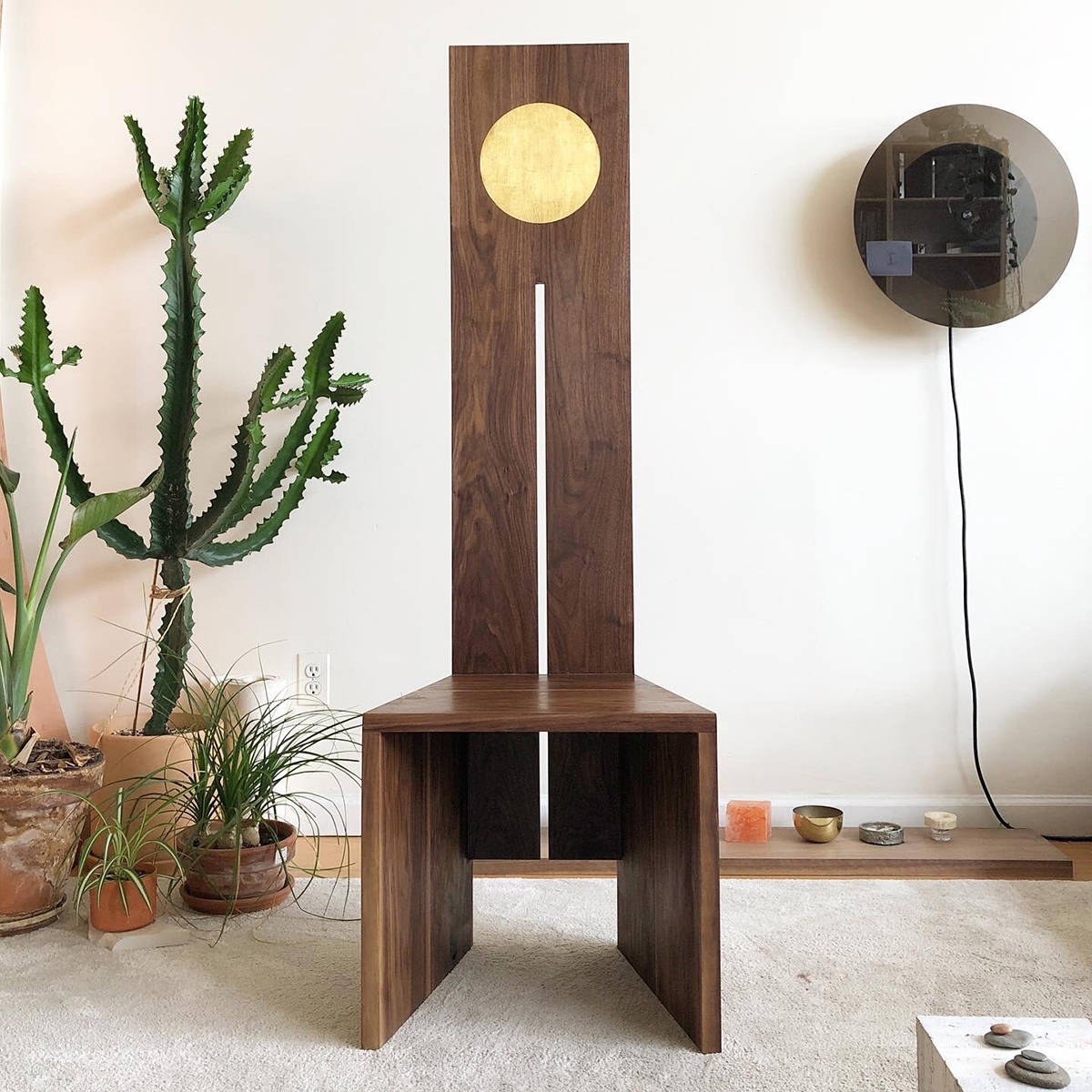
Tell us a little bit about yourself. You had a somewhat circuitous path, so I’m curious to know, how did you end up doing furniture design?
My early life was focused on music, jazz percussion, and drums, which I enjoyed for the exploration of formalizing methodology, like how you move your body in space, as well as the collaboration and community with others in playing music. Which is a nice way to say jamming. Then I moved on to playing guitar and singing and touring. I am certainly a conceptual person and have an active imagination, but music, specifically performing, was always fleeting. I think I was searching for something a bit more tangible. I’d always been building things and I think it was always part of my inquiry just in learning and in life. I was offered a more formalized apprenticeship as a woodworker, where I really started at the very basics — digging fences and post holes, framing houses and shingling — on Martha’s Vineyard island. From there, it just clicked for me. That inquiry led me to historical restoration in Boston. Then when I got to that point I started to have larger questions. I was looking more for the root, so I was led to design.
I went back to school at Parsons, and had this wild couple of years where I was able to make my own curriculum and acquire all the skills that I thought I needed. I wasn’t quite sure what I wanted first. At that point, I was curious about it all. My goal was to have an MFA, but I wasn’t sure exactly where that would be. I started to get to know a lot of faculty and had taken a class with the Dean of Parsons, and he recommended the new MFA program there in industrial design. It seemed to suit me very well and the scholarship was quite nice, which was an incentive. I already started putting down roots in New York and was really enjoying it here.
Your previous pieces were quite experimental, using crushed-up bone and Himalayan salt as materials, why a straightforward woodwork collection this time?
Those pieces encapsulated what I call my material investigation. But after that I was interested in doing more woodworking again, so during the pandemic, I began work on my Home Group One Collection. I was, and still am, really involved with designing spaces and furniture for hospitality clients, but when that all shut down I was able to come into my studio and start making sculptures and drawing pieces again. I was already in contact with Love House gallery, so they gave me a timeline and I just made all this furniture for them in my little live/work studio during the pandemic. So that’s how that all came to be. It was very much allowed to happen because I had the space and time during this very heavy, dark time. Certainly, I was thinking a lot about home. Like what home means to me, which I had also been thinking about a lot in the past even when I was in bands playing music and writing.
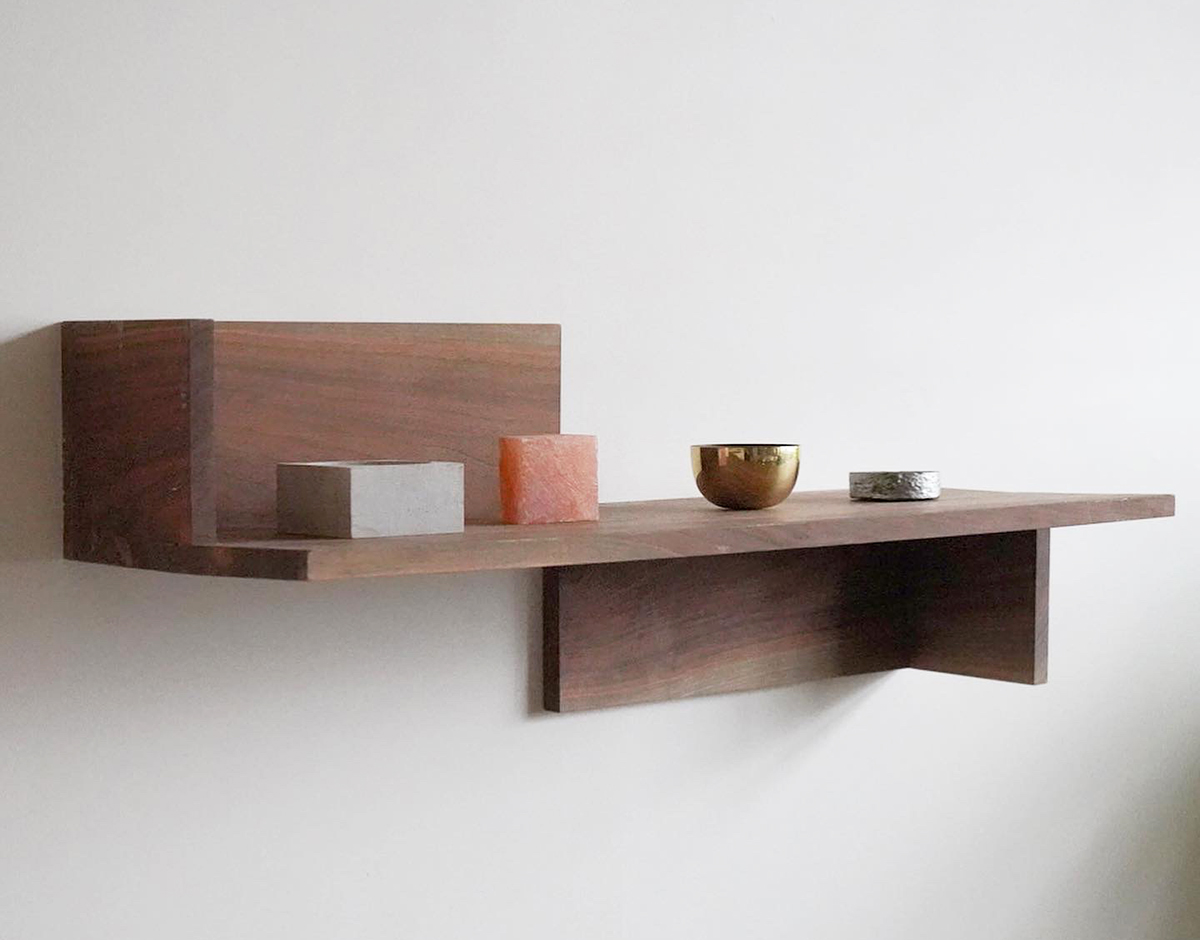
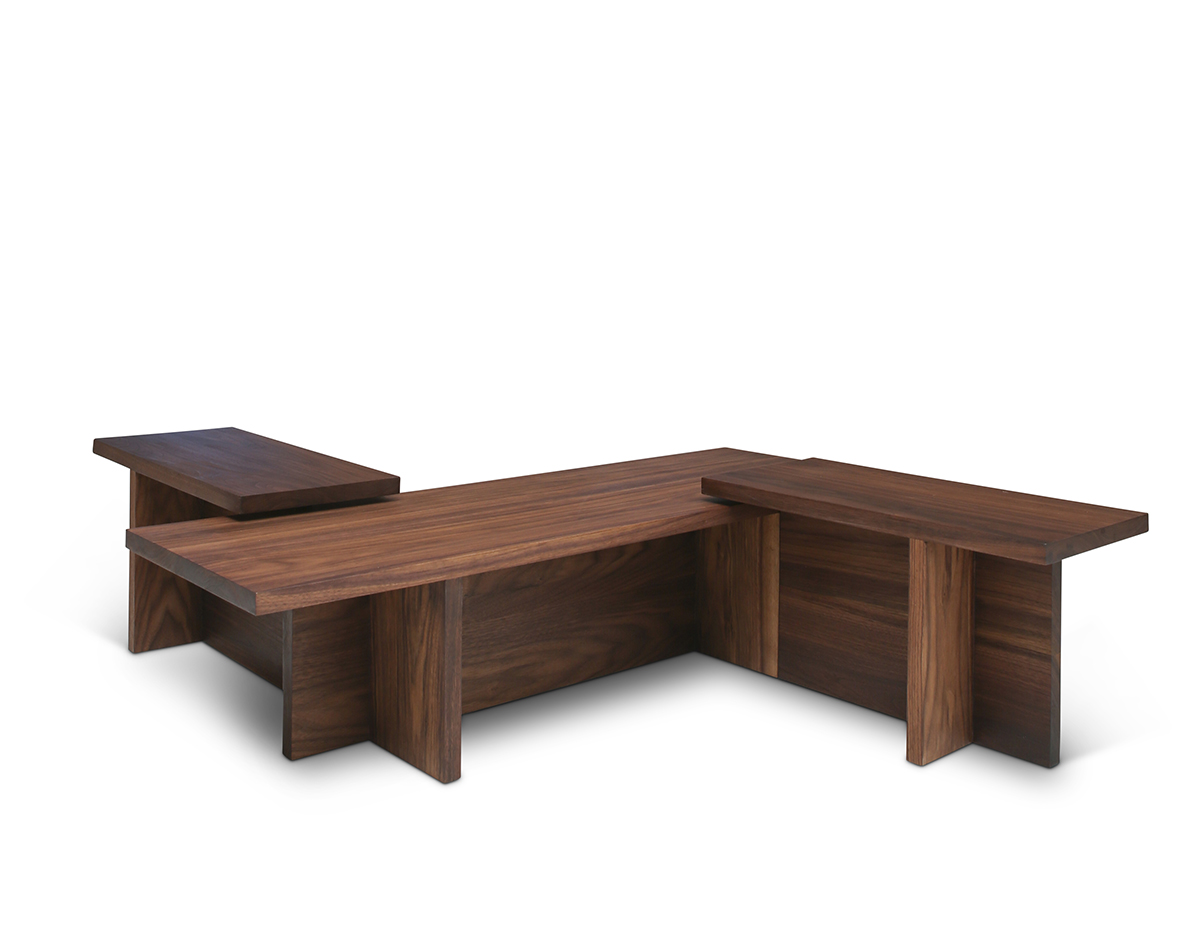
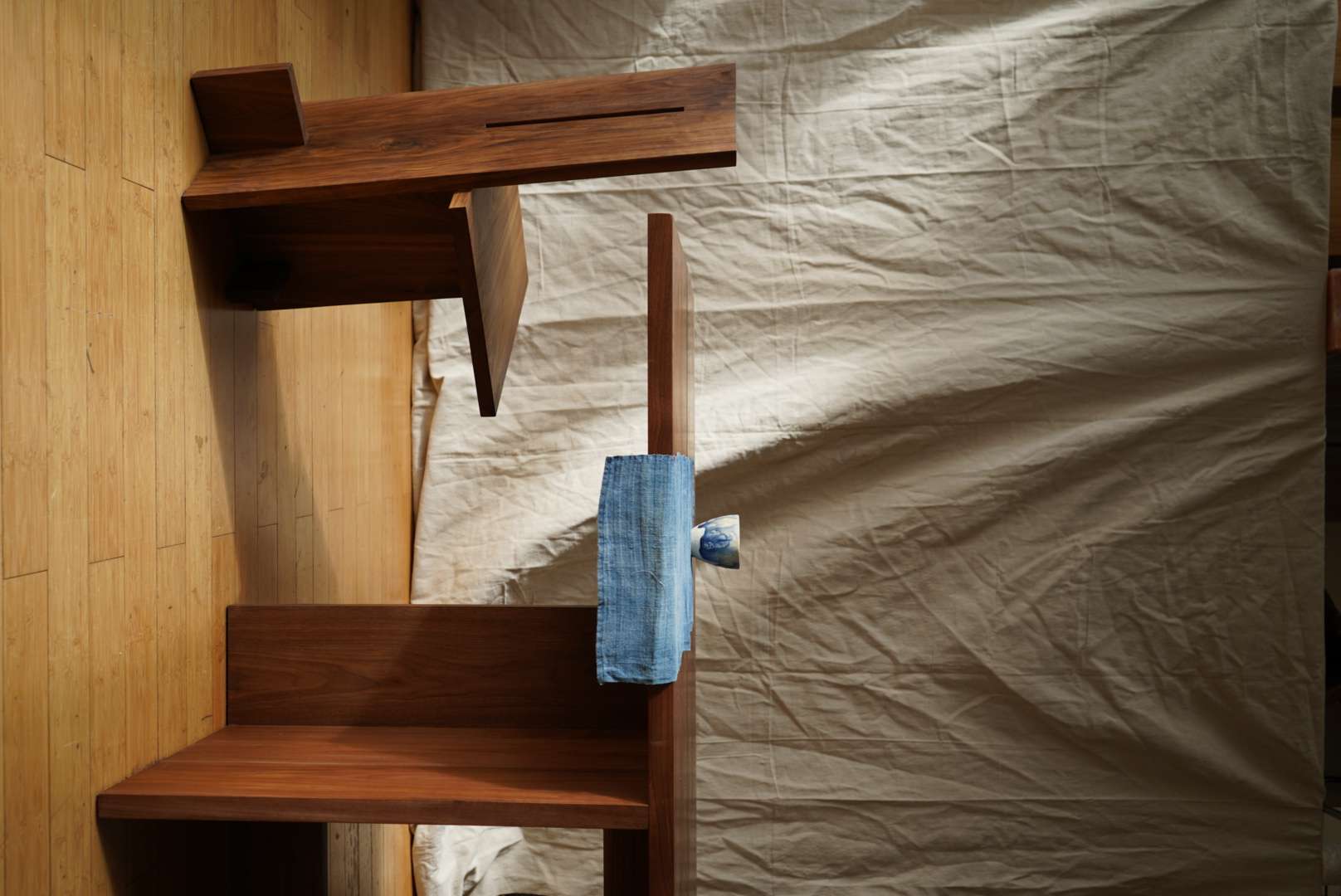
I read that you had devised a metaphysical concept behind the Home Group One collection, that you thought of it as a place to connect spiritually. Can you just kind of go into that for me a bit?
A lot of my interest in design is the poetics of design and the embodied knowledge in the materiality. The memories are embodied in objects from youth, like an old worn table or tool or something like that. How you can build, especially in this time, a sense of place or a sense of home with the objects that surround you because of the politics they embody. Because you’ve had a meal with others at that dinner table, you’re so much more connected to it, it feels like a real marker and place in time for you. I’ve done a lot of research into understanding the traditional home, and the hearth has always been the center, obviously to cook and for warmth. But that has changed as architecture changes. Maybe we’re glossing over a few 100,000 years there, but as we’ve changed to a more refined mode of heating the home, the hearth becomes the stove. But I’ve always thought of the table as the center of the home. It’s where you’re sharing your meal, there’s warmth, there’s conversation, there’s community, somebody can do work at it. There are different levels of interaction, from a solo person in New York having friends over to your family having a large Thanksgiving dinner. No matter the circumstances, it centers the space and allows everybody to connect.
It’s seeing design as more of a holistic project for living rather than purely aesthetics.
That really is a defining characteristic of how I think of my practice. From how I talk about materials to how I think about the client. It’s a whole network and community I’m orchestrating and trying to find harmony within.
Let’s get into your process of designing and building. What’s your starting point?
I work from really rough sketches and ideas. I just allow myself to sketch really badly and very quickly to generate the idea. I then go into Rhino and start to refine it just to understand proportion. I then take that and print it out and draw over it again and start to bring it back to the hand. For me, that hand process is really important. I think of Rhino and CAD and renders are just tools the same way I use a chisel or a plane. If I’m stuck on something or feel like I’m a little too on paper, or on the computer, I’ll just go make something, because I have all these tools and usually have material around. If I need to just see it, I’ll make it. But with the Home Collection, I actually just made them straight away. I felt very confident about it. Other pieces I’ll make study models in pine or something that’s on hand or scraps that are around.
Sourcing material is also really important to the process. The Home Collection is made entirely in walnut from Pennsylvania. I go to a lumberyard in Rockaway that I’ve had a real connection with for years, where he lets me pick the pieces I want by hand. I can take time with the material and really pick out what I want so that I’m not wasting anything because walnut is so slow-growing, and, to me, one of the more beautiful, special woods. I love the dark color and the wild knots and grains and turns and twists in this variation. I’ll take a whole day if I need to, just digging through and finding the pieces I want. If I don’t see it, I won’t buy it. I’ll just wait, which has certainly upset clients before. But if you’re building a table, the idea is for them to be loved and last for a long time. So if I have to wait a week for the next bundle to come in, I think it’s worth it. I start to feel very connected to these pieces. It’s almost hard to let them go.

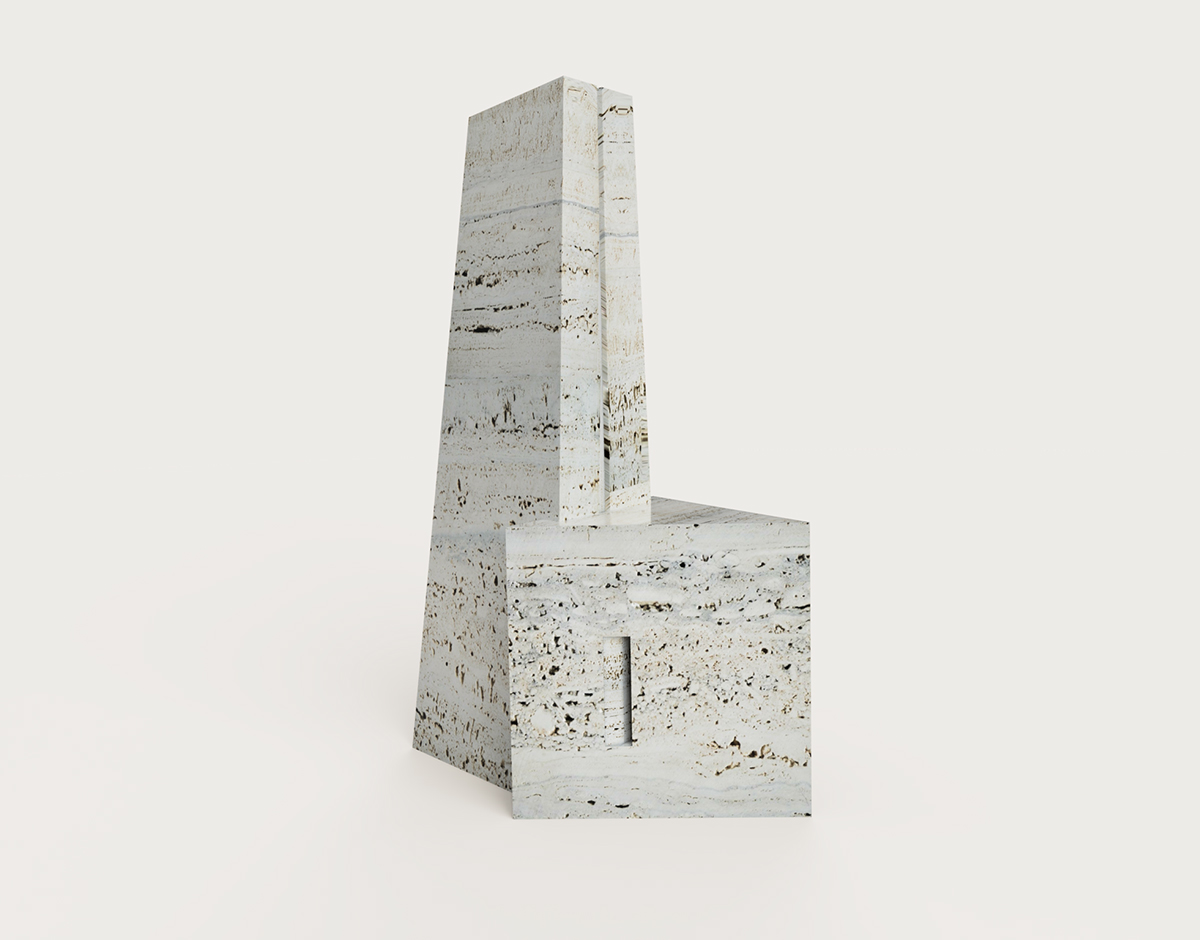
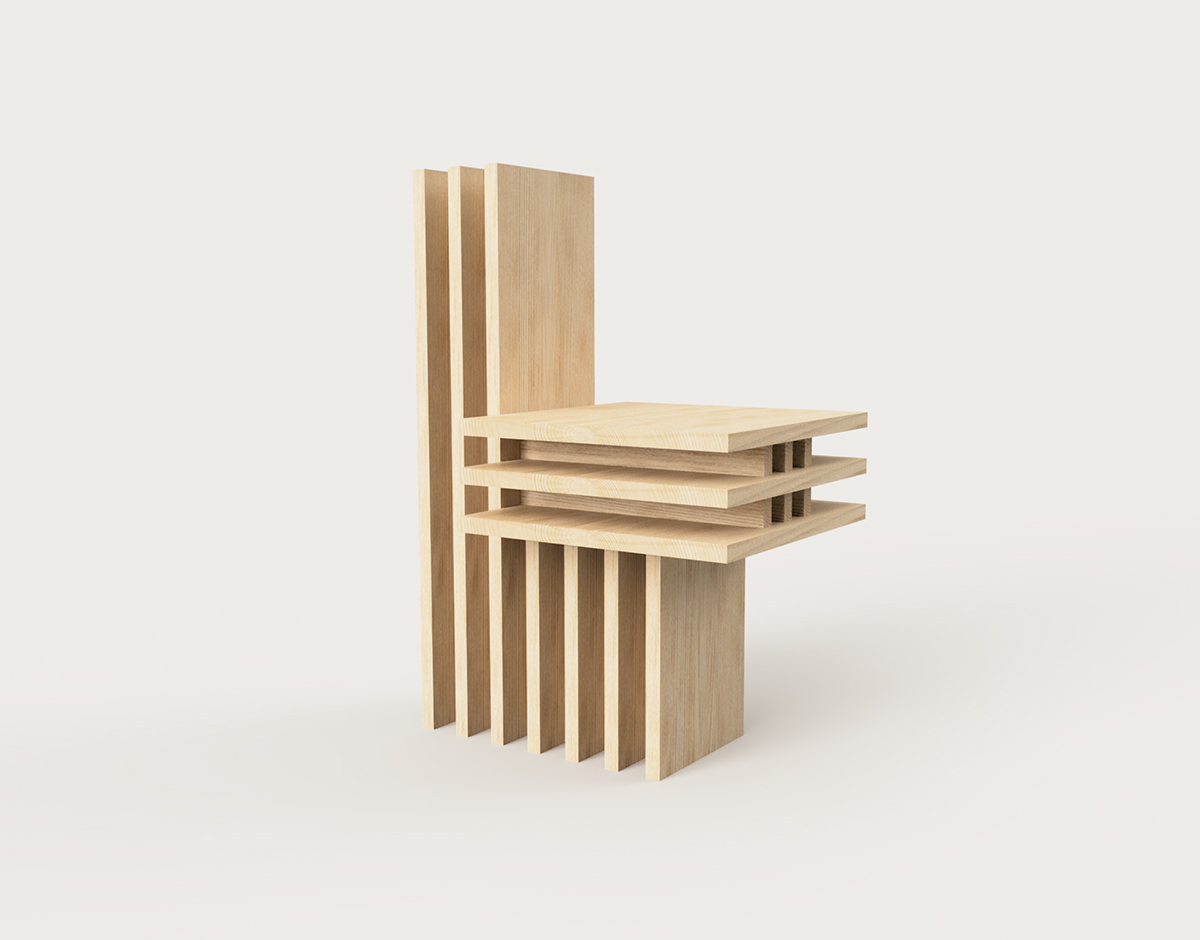
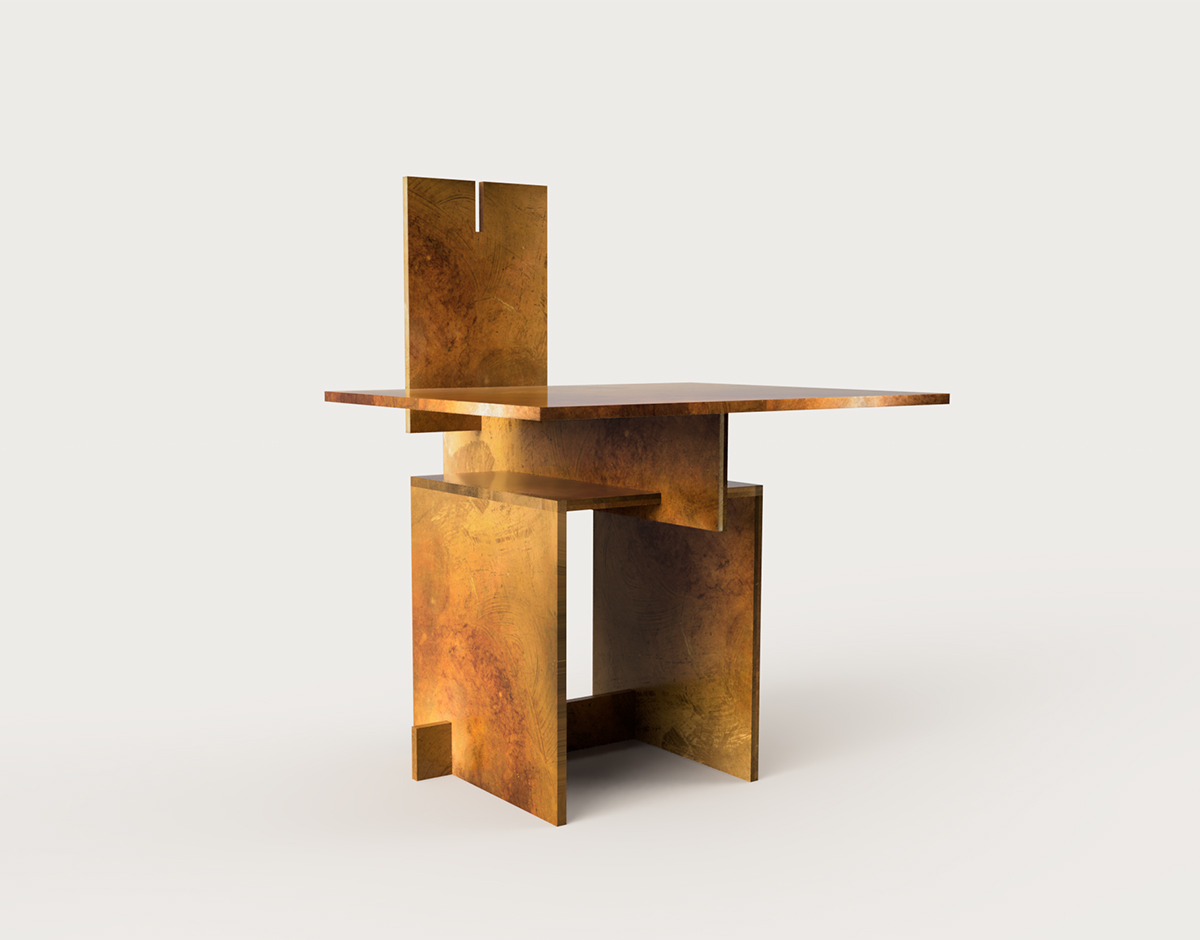
I’m also curious about the pieces you made for the [virtual only] Inside-Out show by Kin & Company, which you’ve said are still a work in progress. All the pieces are very different from one another — a monolithic travertine bench, a copper chair, and a ribbed pine seat — what was the concept or connecting factor between them?
For Inside-Out, material was the connecting factor. The concept came from some material writing and some recordings that I made. Like my previous pieces the Bone Chair and the Salt Chair, they are a little bit subversive. I think I trend that way. The Home Collections is very clear in that it is traditional woodworking, but with Inside-Out, I was reacting to a lot of what I had seen recently. Now that we can render everything, we don’t actually have to make things. We can put pieces in an imaginary desert landscape. How beautiful is it that there is an oasis of design that exists in the ether! And like, I don’t like that. I am so much about actual tangible materials. If I see something in a render, I can appreciate the form, absolutely. But if somebody specified a material that is unrealistic or unsustainable — for example, all this resin casting makes my skin crawl a bit — that’s what I think when I see these renders, you see these wild shapes and you know they would have to be made of, say, foam.
The show started off that we were all going to make pieces for the community to sit at an outdoor park, which is right up my alley. The first thing I designed was a travertine bench that would translate temperature and then I was working with copper that would reflect the sky and the buildings around it. So as that migrated, I was like, okay, how do I translate ideas of materiality into objects? This is maybe why I don’t feel like it’s finalized. Take, for example, the Ribbed Chair, which is made of pine with very straight lines when it’s first made. Pine, generally, is very quick-growing and it’s kiln-dried really fast. The model I have is already starting to curve and crack. The render may look perfect, with perfect lines. But the reality of it is that the actual material is not going to look great over many years, just because of the inherent quality of pine. What I started to think about was how can I make objects portray their materiality in the form that they have and start to ask questions about it? And then how can I have writing that goes along with this to contextualize what I’m thinking about?
And that’s a lot of what I do in my work. I think about how you can approach it and say, okay, these are some things people would call beautiful, or these are nice, or I like these, but then what are the steps into the piece? How do you get to the core of what’s really going on here? What do I know about this material? What do I know about how this would be made? Or even, how would this be in my life? In the end, I had a plan to just never make these and just make T-shirts of them as a bit of a fuck you to this world of renders.
